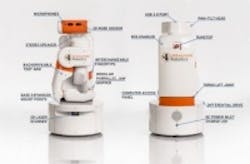Is the one-armed UBR-1 the Model-T of robots?
The UBR-1 robot from Unbounded Robotics is a one-armed; $35,000 robot that will initially be deployed in research environments, but with the robot’s advanced platform, could be launched into a variety of applications. Its creators are even calling it the "Model-T" of robots.
In an interview with IEEE Spectrum, Unbounded Robotics CEO Melonee Wise says the robot, which only comes in orange and white (like the Model-T), has just one arm for a number of reasons. First, she said she thought about the type of research involving robotics that is being done today, and realized a one-armed robot would suffice in many situations. In addition, having only one arm will help reduce the size and cost of the robot. Wise cites Willow Garage’s PR2 robot, which costs about 10 times more than the UBR-1 and has 80 pound arms, compared to a total weight of 160 pound for the UBR-1.
Providing the vision for the UBR-1 robot is a Carmine 1.09 3D sensor from PrimeSense located in the head, and a Hokuyo URG-04LX-UG01 laser scanner in the base. (In the UBR-1S model, the robot uses a Hokuyo UTM-3LX laser sensor.) The Carmine 1.09 3D sensor features a field of view of 57.5 x 45 and a range of 0.35m – 1.4m. It also features 640 x 480 pixels and has color and audio support. In addition, the Carmine 1.09 features USB 2.0 and USB 3.0 interfaces.
The URG-04LX-UG01 has a semiconductor laser diode light source, a 20mm – 4000mm detection distance, a resolution of 1 mm, a scan angle of 240°, and USB 2.0 interface. It also has low-power consumption (2.5W), and weighs only 160g, making it an optimal size for integration into the UBR-1 robot.
The sensor from PrimeSense, which helped to develop the Microsoft Kinect, gathers the data needed for the robot to move its arm, while the laser scanner helps UBR-1 to create real-time maps of its location and maneuver around.
Wise says that the base version of the robot, UBR-1, will likely be used in small workspaces such as research applications, but a second model with a longer-range (30m) laser sensor (UBR-1S), a faster processor and higher top speed, will be released for use in larger environments.
While it’s tough to say whether this is actually the “Model-T” of robots, its compact design and significantly lower price point, along with its autonomous vision system, should garner plenty of interest.
View the IEEE Spectrum interview.
View more information on the UBR-1 robot.
Also check out:
Robots, UAVs used to photograph lions in the wild
Researchers hoping to mimic vision of dragonflies in robots
How robots could remove blood clots with medical imaging and steerable needles
Share your vision-related news by contacting James Carroll, Senior Web Editor, Vision Systems Design
To receive news like this in your inbox, click here.
Join our LinkedIn group | Like us on Facebook | Follow us on Twitter | Check us out on Google +
About the Author

James Carroll
Former VSD Editor James Carroll joined the team 2013. Carroll covered machine vision and imaging from numerous angles, including application stories, industry news, market updates, and new products. In addition to writing and editing articles, Carroll managed the Innovators Awards program and webcasts.
